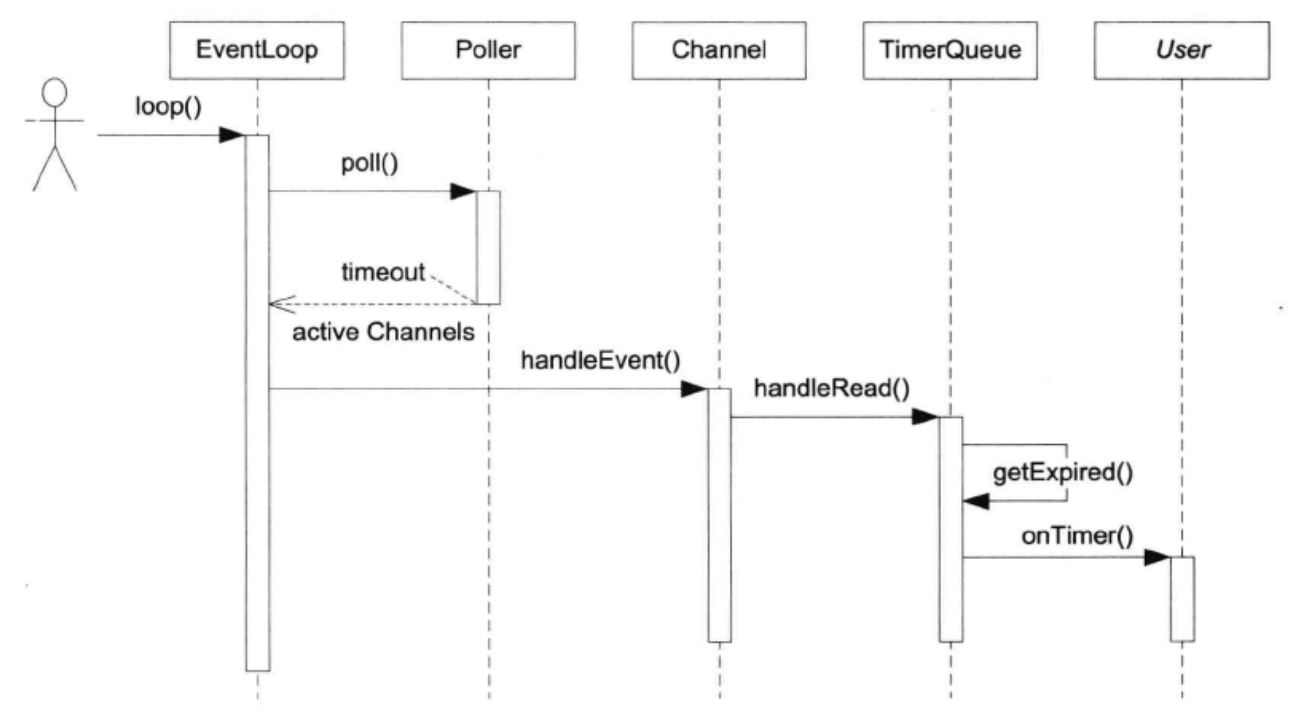muduo - 定时器与TimerQueue
muduo库时间函数的选择
计时:只使用 gettimeofday 来获取当前时间。gettimeofday 的分辨率 (resolution) 是 1 微秒,足以满足日常计时的需要。muduo::Timestamp 用一个 int64_t 来表示从 Epoch 到现在的微秒数,其范围可达上下 30 万年。
定时:只使用 timerfd_* 系列函数来处理定时。(timerfd_create / timerfd_gettime / timerfd_settime)timerfd_create 把时间变成了一个文件描述符,该“文件”在定时器超时的那一刻变得可读,这样就能很方便地融入到 select/poll 框架中,用统一的方式来处理 IO 事件和超时事件,这也正是 Reactor 模式的长处。
Timer* 类的设计与实现
TimerId非常简单,它被设计用来取消Timer的,它的结构很简单,只有一个Timer指针和其序列号。TimerQueue为其友元,可以操作其私有数据。
Timer封装了定时器的一些参数,例如超时回调函数、超时时间、定时器是否重复、重复间隔时间、定时器的序列号。其函数大都是设置这些参数,run()用来调用回调函数,restart()用来重启定时器(如果设置为重复)。
TimerQueue其实现时基于Set的。TimerQueue的封装是为了让未到期的时间Timer有序的排列起来,这样,能够根据当前时间找到已经到期的Timer也能高效的添加和删除Timer。内部有channel,和timerfd关联。添加新的Timer后,在超时后,timerfd可读,会处理channel事件,之后调用Timer的回调函数;在timerfd的事件处理后,还有检查一遍超时定时器,如果其属性为重复还有再次添加到定时器集合中。
这里涉及了3个类TimerId、Timer、TimerQueue要知道他们怎么与EventLoop结合起来,还是从一个示例开始。简单来说,TimerQueue是用来进行管理调度的,而Timer是真正的超时事件(该Class中封装了真正的超时回调)。
void printTid()
{
printf("pid = %d, tid = %d\n", getpid(), muduo::CurrentThread::tid());
printf("now %s\n", muduo::Timestamp::now().toString().c_str());
}
void print(const char* msg)
{
printf("msg %s %s\n", muduo::Timestamp::now().toString().c_str(), msg);
if (++cnt == 20)
{
g_loop->quit();
}
}
int main()
{
printTid();
muduo::EventLoop loop;
g_loop = &loop;
print("main");
loop.runAfter(1, boost::bind(print, "once1"));
#if 1
loop.runAfter(1.5, boost::bind(print, "once1.5"));
loop.runAfter(2.5, boost::bind(print, "once2.5"));
loop.runAfter(3.5, boost::bind(print, "once3.5"));
loop.runEvery(2, boost::bind(print, "every2"));
loop.runEvery(3, boost::bind(print, "every3"));
#endif
loop.loop();
print("main loop exits");
sleep(1);
}
首先,是EventLoop类对象的初始化:
EventLoop::EventLoop()
: looping_(false),
quit_(false),
eventHandling_(false),
callingPendingFunctors_(false),
iteration_(0),
threadId_(CurrentThread::tid()),
poller_(Poller::newDefaultPoller(this)),
timerQueue_(new TimerQueue(this)),
wakeupFd_(createEventfd()),
wakeupChannel_(new Channel(this, wakeupFd_)),
currentActiveChannel_(NULL)
{
...
}
这里,我们看到在EventLoop的构造函数中对Poller和TimerQueue类型的成员进行初始化。然后,看TimerQueue的构造函数:
TimerQueue::TimerQueue(EventLoop* loop)
: loop_(loop),
timerfd_(createTimerfd()), //timefd描述符
timerfdChannel_(loop, timerfd_), //channel对象
timers_(), //保存Timer的关键结构
callingExpiredTimers_(false)
{
timerfdChannel_.setReadCallback(
std::bind(&TimerQueue::handleRead, this));
// we are always reading the timerfd, we disarm it with timerfd_settime.
timerfdChannel_.enableReading();
}
将timefd和Channel关联起来,并绑定TimerQueue::handleRead作为描述符可读时的回调函数,而在TimerQueue::handleRead中又会去调用超时的Timer的回调。
void TimerQueue::handleRead()
{
loop_->assertInLoopThread();
Timestamp now(Timestamp::now());
readTimerfd(timerfd_, now);
std::vector<Entry> expired = getExpired(now);//关键处理逻辑
callingExpiredTimers_ = true;
cancelingTimers_.clear();
// safe to callback outside critical section
for (const Entry& it : expired)
{
it.second->run(); //Timer的回调
}
callingExpiredTimers_ = false;
reset(expired, now);
}
其中
Timer(TimerCallback cb, Timestamp when, double interval)
: callback_(std::move(cb)),
expiration_(when),
interval_(interval),
repeat_(interval > 0.0),
sequence_(s_numCreated_.incrementAndGet())
{ }
void run() const
{
callback_();
}
TimerQueue的关键处理函数getExpired的实现,它会从timers_中移除已到期的Timer,同时更新activeTimers_(主要在cancelInLoop中使用,取消活动的定时器),并通过vector返回超期的Timer。
typedef std::pair<Timestamp, Timer*> Entry;
typedef std::set<Entry> TimerList;
typedef std::pair<Timer*, int64_t> ActiveTimer;
typedef std::set<ActiveTimer> ActiveTimerSet;
TimerList timers_;
ActiveTimerSet activeTimers_; // for cancel()
//TimerQueue的结构
std::vector<TimerQueue::Entry> TimerQueue::getExpired(Timestamp now)
{
assert(timers_.size() == activeTimers_.size());
std::vector<Entry> expired;
Entry sentry(now, reinterpret_cast<Timer*>(UINTPTR_MAX));
TimerList::iterator end = timers_.lower_bound(sentry);//返回第一个大于等于now的迭代器,小于now的都已经超时
assert(end == timers_.end() || now < end->first);
std::copy(timers_.begin(), end, back_inserter(expired));//[begin end)之间的元素追加到expired末尾
timers_.erase(timers_.begin(), end);//删除超时定时器
//for (const Entry& it : expired)
for (std::vector<Entry>::iterator it = expired.begin();
it != expired.end(); ++it)
{
ActiveTimer timer(it.second, it.second->sequence());
size_t n = activeTimers_.erase(timer);//删除超时定时器,即同步timers_和activeTimers_
assert(n == 1); (void)n;
}
assert(timers_.size() == activeTimers_.size());
return expired;
}
构造函数帮我们做了很多事情,不过上述情况是假设TimerQueue中已经有一系列已经排好序列的时间事件了,现在要来看看怎么添加这些时间。对应EventLoop中的函数就是runAt、runAfter、runEvery,这三个函数其实底层调用的TimeQueue::addTimer函数,只是传参不同而已。addTimer函数只负责转发,addTimerInLoop完成修改定时器列表的工作。
TimerId EventLoop::runAt(Timestamp time, TimerCallback cb)
{
return timerQueue_->addTimer(std::move(cb), time, 0.0);
}
TimerId EventLoop::runAfter(double delay, TimerCallback cb)
{
Timestamp time(addTime(Timestamp::now(), delay));
return runAt(time, std::move(cb));
}
TimerId EventLoop::runEvery(double interval, TimerCallback cb)
{
Timestamp time(addTime(Timestamp::now(), interval));
return timerQueue_->addTimer(std::move(cb), time, interval);
}
TimerId TimerQueue::addTimer(TimerCallback cb,
Timestamp when,
double interval)
{
Timer* timer = new Timer(std::move(cb), when, interval);
loop_->runInLoop(
std::bind(&TimerQueue::addTimerInLoop, this, timer));
return TimerId(timer, timer->sequence());
}
void TimerQueue::addTimerInLoop(Timer* timer)
{
loop_->assertInLoopThread();
bool earliestChanged = insert(timer);
if (earliestChanged)
{
resetTimerfd(timerfd_, timer->expiration());
}
}
整个处理过程如下:
- EventLoop的构造函数创建TimerQueue的对象,TimerQueue构造函数中创建timerfd,并通过timerfdChannel_绑定timerfd和loop,设置超时回调该回调将用来调用Timer的callback_。
- EventLoop通过runAt、runAfter、runEvery添加Timer和设置Timer的回调,这三个函数是通过设置不同的参数去调用TimeQueue::addTimer。
- 此时定时器已经启动,当发生超时事件时,timerfd可读,poll调用返回。
- 通过activeChannl返回活跃事件(这里的活跃事件即为timerfd可读事件)
- 在Channel::handleRead()回调中将执行在TimerQueue构造函数中绑定的TimerQueue::handleRead()。
- TimerQueue::handleRead()又将获取所有超时的Timer并执行Timer中的回调。
TimerQueue回调用户代码onTime的时序图:

